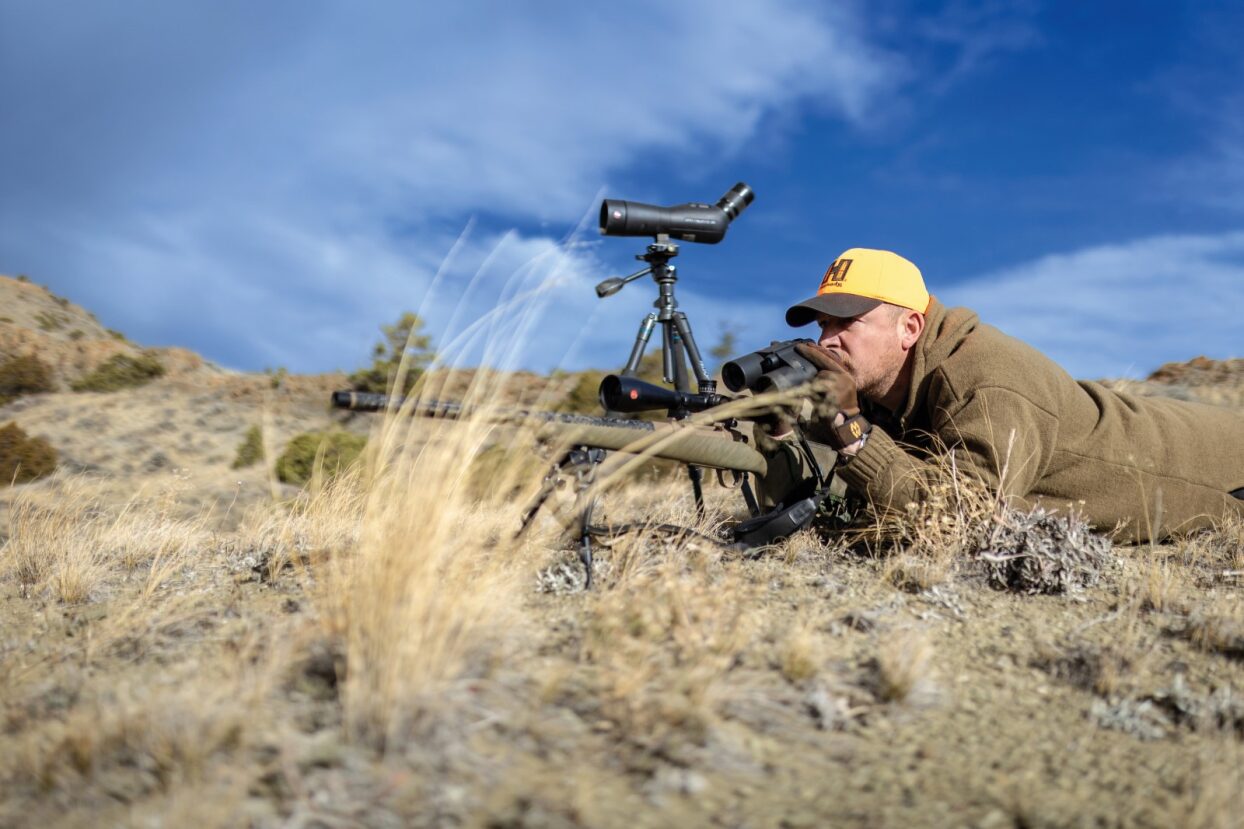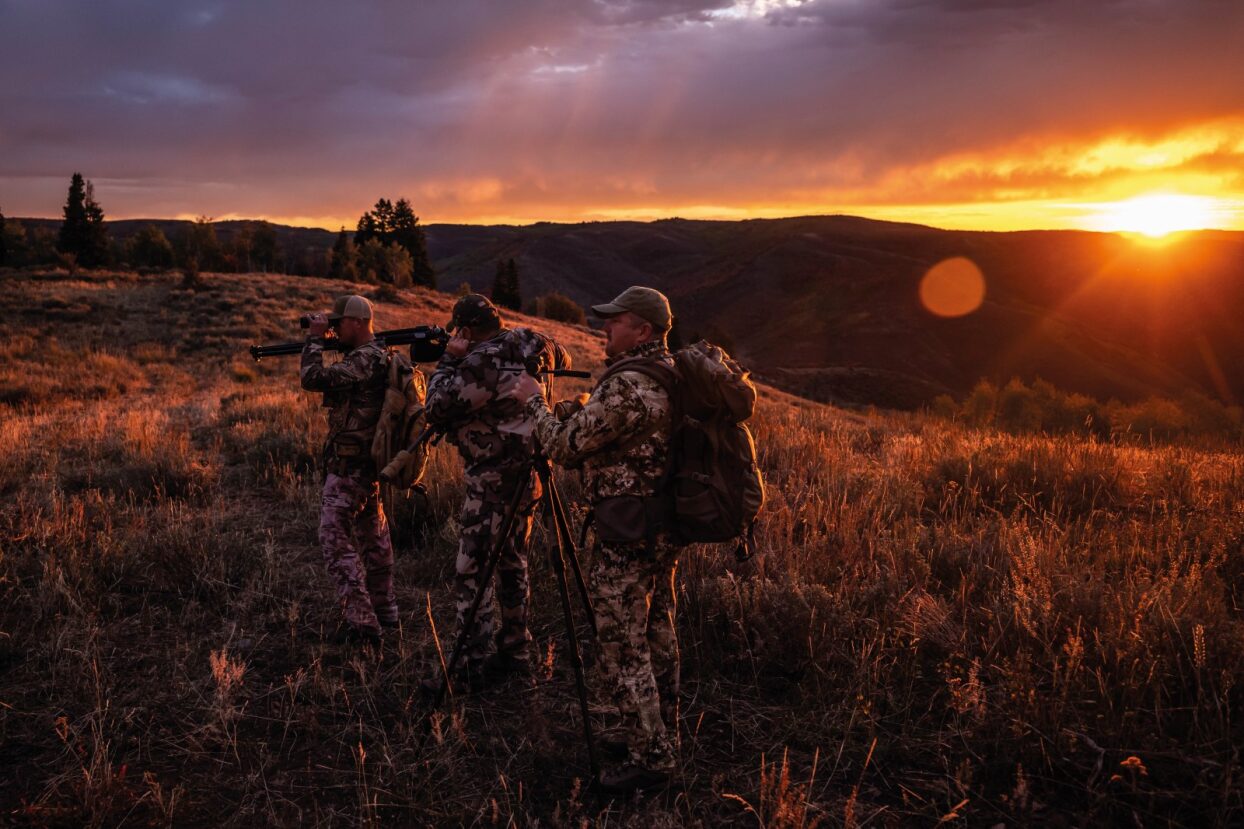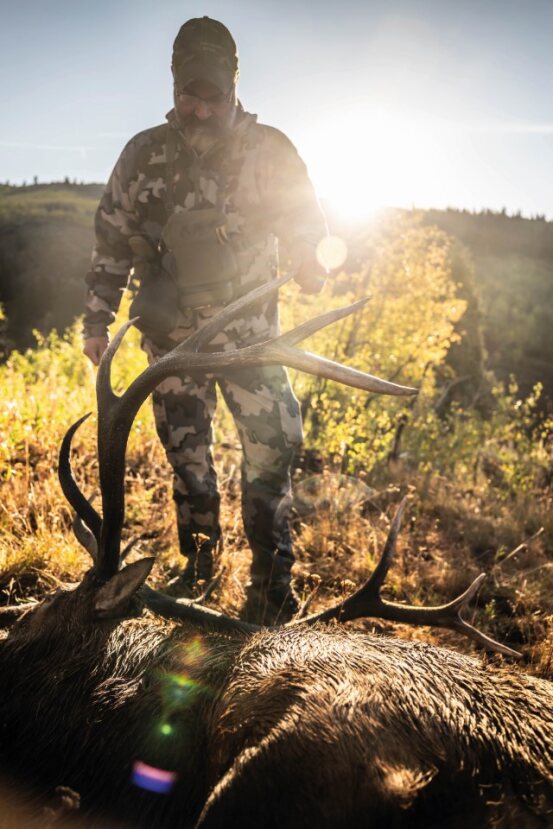It’s the sort of invitation that fills even an experienced hunter with feverish anticipation. I had been invited to take part in the annual Hornady elk hunt, hosted by Jason Hornady and guided by Wild Country Outfitters.
Utah is a long way from my home in Scotland, but I was keen to embark on the 4,600-mile journey – particularly for such a special event that has been running for decades and is always scheduled during the peak of the rut.
September is a wonderful time of year to be in the western States, and Utah is particularly beautiful. The aspens are changing from summer green through the spectrum to yellow and then to a crimson red before dropping their leaves for winter. This colour change is almost unearthly, transforming the landscape over little more than 10 days. There’s something startling about seeing time pass so quickly. The banks of aspen are overwhelming in their beauty and the sage covers the rolling hills as far as you can see. Somewhere, among it all, are the elk.
TEEMING WITH LIFE
The land we were to hunt on is leased by Hornady, and is part of a programme in Utah that aims to promote wildlife conservation and enhance hunting access on private rangelands. Areas known as Cooperative Wildlife Management Units (CWMUs) are managed for game and other wildlife, informed by research and science. The benefits for a vast array of flora and fauna are huge.
The hills and forests on the CWMU heave with wildlife – huge elk herds, mule deer, Shiras moose and a host of smaller species. This healthy, balanced ecosystem is a true indicator that the management plan is working and that targeted hunting, as a means of funding conservation, is doing what it should.
A key indicator of success in this area is the sheer number of old elk on this enormous property. The management plan focuses on allowing the bulls to reach a natural rare old age before being considered a ‘shooter’.
This ensures the smartest, strongest and toughest animals – the old boys that hold ground and hold cows – pass on their genes to the next generation. The result is a herd structure with a perfectly balanced age class, meaning there are a lot of enormous elk racks to get excited about.
 In this vast landscape, fitness is just important as hunting ability
In this vast landscape, fitness is just important as hunting ability
THE ASPENS BECKON
The experience of hunting elk is a rich one, with the soundscape being as spectacular as the visually mind- blowing landscape. I often found myself closing my eyes to listen. During the rut the elk bulls ‘bugle’, creating an eerie sound that starts high and descends into a guttural combination of a whistle and a roar. It’s deeply primitive and, in all honesty, quite terrifying. Nothing like a red stag’s roar, the call is more similar to the high shrill of another cervus cousin, the sika stag. The bugle has two aims: to lure cows into a harem and to demonstrate dominance over any would-be master bulls.
I was paired for the week with a couple of great industry friends: George Gardner of GA Precision and Neil Davies, marketing director of Hornady. George knows his long- range and precision shooting well, which has helped immensely in developing several Hornady cartridges including the 6mm Creedmoor. He is also co-founder of the popular – and now global – Precision Rifle Series. I have happily hunted internationally with Neil many times, so it was a lot of fun to get out with him on his home soil.
Neil was hosting George and me, as we would be shooting Hornady’s newly developed 7mm PRC, billed as the most efficient 7mm cartridge ever produced. We were being guided by Scott Miller (known simply as Miller), a seasoned guide able to call elk in their odd language and mercifully thick-skinned enough to put up with our childish ribbing during this week-long adventure. I knew that having Neil and George in tow would add another dimension of fun to the hunt. Although from different sides of the pond, we share a sense of humour and already feature in several of each other’s campfire yarns.
Back in Scotland I am well-acquainted with red deer, which share some characteristics with American elk, albeit on a much smaller scale. A mature elk bull is about four times the weight of a mature red stag, weighing around 700-850lb, but their colouration and antler structure do bear many similarities. For much of the year the old bulls become ghosts in the forest, creeping around and rarely seen, but during the rut their caution fades and they emerge with one thing on their minds.
 Simon didn't have to wait long for a shooting opportunity
Simon didn't have to wait long for a shooting opportunity
GETTING STARTED
Our first morning started before sunrise. With multiple guests on the hunt, we had drawn the furthest hunting area from camp, deep in the forested hills. We piled into a truck, also four times the size of anything you’d see in Scotland, and the chat about animal choice started. We would be ultra-selective. We had a whole week and there was no rush to get this monster job done.
George generously insisted that I hunt first, given it was my first elk, but it was made abundantly clear to me that I wouldn’t be shooting that morning. Miller didn’t want me to surrender to my greed and take a ‘first-morning bull’. We had time, so we could be steady and I needed to observe a hoard of bulls until I understood what we were looking for. Then we could go for something special.
We set off from the truck as the sun lifted to reveal some of the most amazing terrain I’d ever seen. The elk were bugling loudly, and Neil reminded me of the Jurassic Park scene when the party first encounter a herd of brachiosaurs. I liked the analogy, but it didn’t touch the sides. Utah was simply pumping with elk, beauty and adrenaline – mine and theirs. What a place to be alive.
 The 7mm PRC. Could this be the ulimate all-rounder?
The 7mm PRC. Could this be the ulimate all-rounder?
Two hours into the day, my nerves and emotions settling a little, we could get on with the business of observing the bulls and piecing together a plan. It is very difficult to identify the size of a bull just from the bugle, despite what you may be told. However, we’d seen and heard a huge amount of activity, with some serious clashing of antlers in a stand of aspen that appeared to be the epicentre of this valley’s bugling. Miller explained that the aggressor is likely to be something bigger. This had to be an old boy.
Closing in on the edge, we started to peer through the limbs of aspen, trying to get a glimpse of just how big this bull was. Was he broken on one side, was he just a strong younger bull, or was he just what we wanted to see on my first morning’s lesson in elk observation? Finally we got eyes on him. He was magnificent. Luck, pure and simple, was on our side. Just by standing, the pressure from him was enough to gently move an estimated 50 animals or more. Four hours of cat and mouse followed until we got a full spotting scope view of the bull in the open.
THE BEST LAID PLANS
This is when the morning’s plan unravelled. After deep consultation with Neil and George, Miller decided that the prohibition on a first-morning bull may need to be lifted. This was no ordinary bull and was like nothing the outfitters had seen for some weeks; it could be the best I would see. I needed little persuasion, knowing I would have the rest of the week to accompany George. And that was it. We were no longer simply observing; we were hunting.
My focus changed and it was time to go. We’d seen the herd with the bull going into a clump of evergreen timber. It was around 09:30 when this happened, a good few hours in. We managed to find a solid position for me to get prone and set up on a bank with a draw between us and the timber, with a clearing to the left. Miller told me they often go into trees to bed down at this time of day, but there was still a lot of activity, which was unusual.
The bulls carried on rutting hard. We heard huge amounts of kinetic elk activity, a war zone of groaning, bugling and crashing antlers. Younger bulls would enter to chance their luck with big bull’s harem of cows, and we’d see them being chased out, tails between their legs. He’d poke his head out of the timber into a clearing, the one I hoped I might shoot him in, to reinforce his dominance for a couple of seconds. Victorious over the lesser bulls, he would then disappear again out of sight. Being among these creatures while they rut is hard to describe. You feel an impostor in their space, as if you shouldn’t be there.
The clearing was a couple of acres in size and about 150yd from front to back. I got to know it well through my scope and binos. We hoped he would eventually show himself and walk across the open space, drunk on testosterone, but the chances of this working out hung in the balance. After two hours, we decided that making a move could get a better result. There may be a window into the thick timber for a shot from another angle.
As I rose from lying prone with a two-hour cramp, a cow spied us and started stomping her front right hoof in our direction. With so many beasts deep in the timber we knew something was about to happen, good or bad. If goes, they all go. The cow gently started moving, picking up other cows in her wake. Soon they were trotting and then galloping through the thick stuff into the clearing. I ran back to the depression I’d made in the grass and dropped.
 An epic landscape and the hunting opportunity of a lifetime
An epic landscape and the hunting opportunity of a lifetime
THE SHOT
I had already ranged the different sections: front edge to back, edge to edge, 200yd at the front, 350yd at the back. I anticipated it would be a nano-second opportunity if he showed himself, as he’d be in hot pursuit of the cows, unaware that we’d spooked them. Eventually he showed and in that split second chaos reigned as multiple cows ran past him through the clearing. The bull charged forward and presented no shot at full tilt. I prepared myself for a moment of pause or hesitation; maybe he would look back to see if any other cows were following him.
He came almost all the way across the clearing in one run before turning for less than the half breath I could take to steady myself to see the sub-tensions of the reticle. Miller made a cow call across to him, inciting him to pause and bugle to try and call the errant cow back into his harem. He spun around, gave one more bugle and stopped, facing away from my position but twisting the front half of his body towards me.
This gave me just enough time for a shot. He was at the far side of the clearing and my scope was pre-dialled. I fired, steady and sure. It was quick but it felt good. At 330yd, this was a challenging but makeable shot, especially with the most efficient 7mm ever developed throwing 175gr of projectile at 3,000fps.
Neil, George and Miller saw the shot land. I reloaded, ready for to fire again, but he’d moved off into cover while the cows continued pouring across the clearing. I’d connected and somewhere in the trees the bull was down.
 And now the real work begins
And now the real work begins
JUST THE BEGINNING
Once all activity had subsided, we walked down the draw to look for the felled bull. He was motionless, 100yd from where he’d been hit. Walking up to this dead animal was overwhelming – he was the most magnificent creature I’d ever taken and despite being a first-morning bull he was well worth curtailing my hunt for. He was around 750lb in weight and had an interesting rack. A classic elk bull has six points on either side; this old boy had five on one and six on the other, with atypical palmations and mass. He had character; a big bull with a big experience in the most spectacular of landscapes.
It’s clichéd to say this, as Neil reminded me, but the shot is only the beginning of the hunt. To start with there is a legal obligation to remove all edible meat from the carcass.
You need to pack the meat out – and at 65lb a hind quarter there is a lot to carry to where you can get a vehicle. It was a big effort. We couldn’t get a vehicle anywhere near, so we cut him up, took off the back straps, neck meat and all four quarters, and started the trek through the forest back to a track. The prize is worth the effort, and thankfully I had mostly willing companions to support the endeavour.
The next five days were spent in pursuit of a bull for George, immersed in the rut, landscape and good company. The physicality was what I’d expected. Elk live in undulating, mountainous terrain and you have to go where they are. It was punishing but pleasing. One day we pounded 16,000ft of elevation over only six miles. To achieve that in a day is exhausting but highly rewarding in such a magical environment.
Mine was a first-morning bull; George’s was a last- morning bull. Having observed hundreds of potential shooters over huge swathes of the Utah wilderness, George caught up with another monster with a 480yd shot across a valley off sticks. A suitably long-range shot for someone with such a pedigree in this art, showing the capabilities of both his shooting skill and the 7mm PRC.
This hunt in north-eastern Utah was about more than just pursuing game; it was an exploration of nature’s wonder, a celebration of camaraderie and a test of physicality. The memories created during those days, the shared laughter and the lessons learned made that trip one of my most cherished hunts. Hunting isn’t merely about passion, wildlife management or meat harvest. It’s a tapestry of experiences, emotions and connections that enrich our lives in ways that words can scarcely capture. The ethereal quality of hunting during the rut is unparalleled. The elk calls that reverberate through the air create an atmosphere that transports you to a different realm.
Beyond the trigger pull, the journey was inspiring and it’s something I will certainly do again. But perhaps ‘again’ isn’t the right word. That landscape is forever changing and the populations of the wild animals that live there are forever changing too. You never truly hunt in the same place twice.
THE ULTIMATE ALL-ROUNDER?
When Hornady started their foray into Precision Rifle Cartridges (PRC) they wanted to work on efficiency and make products that were better than anything that had come before.
I like to hunt smaller deer, goats and sheep as well as medium-to-large game at longer ranges in the mountains, and this means I have needed to use two calibres: 6.5 PRC and .300 PRC.
However, I would love to have just one calibre that covers all hunting scenarios and game species up to dangerous game. The 7mm PRC is the perfect fit, with a great bullet selection up to 180gr. It’s super-efficient, flying flat at 3,000fps. From 1yd to 500yd, it’s going to be one minute of elk, which suits me perfectly.
The 7mm PRC has a beautiful aerodynamically profiled bullet sitting way out of the case, where it’s supposed to be, with a fully burned payload of powder before the bullet leaves the muzzle. Having seen its effectiveness on such an enormous animal at long range, I can testify that this is a very efficient 7mm indeed. With its irritating belt and magnum length action, I have decided to retire my trusty .300 Win Mag for mountain hunts. Without wanting to risk overdoing it, I will be adopting the 7mm PRC for everything.
KIT BOX
Hornady 7mm PRC Precision Hunter 175 grain
hornady.com
Leica Geovid R 10x42 rangefinding binocular
Lecia Amplus 6 3-18x44i L-4w BDC (MoA) riflescope
leica-camera.com/sport-optics
GA Precision Custom 7mm PRC
gaprecision.net